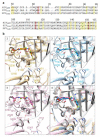Integrase Strand Transfer Inhibitors Are Effective Anti-HIV Drugs
- PMID: 33572956
- PMCID: PMC7912079
- DOI: 10.3390/v13020205
Integrase Strand Transfer Inhibitors Are Effective Anti-HIV Drugs
Abstract
Integrase strand transfer inhibitors (INSTIs) are currently recommended for the first line treatment of human immunodeficiency virus type one (HIV-1) infection. The first-generation INSTIs are effective but can select for resistant viruses. Recent advances have led to several potent second-generation INSTIs that are effective against both wild-type (WT) HIV-1 integrase and many of the first-generation INSTI-resistant mutants. The emergence of resistance to these new second-generation INSTIs has been minimal, which has resulted in alternative treatment strategies for HIV-1 patients. Moreover, because of their high antiviral potencies and, in some cases, their bioavailability profiles, INSTIs will probably have prominent roles in pre-exposure prophylaxis (PrEP). Herein, we review the current state of the clinically relevant INSTIs and discuss the future outlook for this class of antiretrovirals.
Keywords: HIV; INSTIs; antiviral therapy; drug resistance; integration.
Conflict of interest statement
The content of this publication does not necessarily reflect the views or policies of the Department of Health and Human Services or the National Institutes of Health, nor does the mention of trade names, commercial products, or organizations imply endorsement by the U.S. government.
Figures







Similar articles
-
Efficacies of Cabotegravir and Bictegravir against drug-resistant HIV-1 integrase mutants.Retrovirology. 2018 May 16;15(1):37. doi: 10.1186/s12977-018-0420-7. Retrovirology. 2018. PMID: 29769116 Free PMC article.
-
Comparative Analyses of Antiviral Potencies of Second-Generation Integrase Strand Transfer Inhibitors (INSTIs) and the Developmental Compound 4d Against a Panel of Integrase Quadruple Mutants.Viruses. 2025 Jan 16;17(1):121. doi: 10.3390/v17010121. Viruses. 2025. PMID: 39861910 Free PMC article.
-
Structure-Guided Optimization of HIV Integrase Strand Transfer Inhibitors.J Med Chem. 2017 Sep 14;60(17):7315-7332. doi: 10.1021/acs.jmedchem.7b00596. Epub 2017 Aug 10. J Med Chem. 2017. PMID: 28737946 Free PMC article.
-
Different Pathways Conferring Integrase Strand-Transfer Inhibitors Resistance.Viruses. 2022 Nov 22;14(12):2591. doi: 10.3390/v14122591. Viruses. 2022. PMID: 36560595 Free PMC article. Review.
-
A clinical review of HIV integrase strand transfer inhibitors (INSTIs) for the prevention and treatment of HIV-1 infection.Retrovirology. 2022 Oct 22;19(1):22. doi: 10.1186/s12977-022-00608-1. Retrovirology. 2022. PMID: 36273165 Free PMC article. Review.
Cited by
-
Epigenetic silencing by the SMC5/6 complex mediates HIV-1 latency.Nat Microbiol. 2022 Dec;7(12):2101-2113. doi: 10.1038/s41564-022-01264-z. Epub 2022 Nov 14. Nat Microbiol. 2022. PMID: 36376394 Free PMC article.
-
Altered HIV-1 mRNA Splicing Due to Drug-Resistance-Associated Mutations in Exon 2/2b.Int J Mol Sci. 2021 Dec 23;23(1):156. doi: 10.3390/ijms23010156. Int J Mol Sci. 2021. PMID: 35008581 Free PMC article.
-
Inhibition of matrix metalloproteinases by HIV-1 integrase strand transfer inhibitors.Front Toxicol. 2023 Feb 21;5:1113032. doi: 10.3389/ftox.2023.1113032. eCollection 2023. Front Toxicol. 2023. PMID: 36896351 Free PMC article.
-
Dolutegravir Inhibition of Matrix Metalloproteinases Affects Mouse Neurodevelopment.Mol Neurobiol. 2021 Nov;58(11):5703-5721. doi: 10.1007/s12035-021-02508-5. Epub 2021 Aug 14. Mol Neurobiol. 2021. PMID: 34390469 Free PMC article.
-
Antiretroviral Treatment of HIV-2 Infection: Available Drugs, Resistance Pathways, and Promising New Compounds.Int J Mol Sci. 2023 Mar 21;24(6):5905. doi: 10.3390/ijms24065905. Int J Mol Sci. 2023. PMID: 36982978 Free PMC article. Review.
References
-
- U.S. Department of Health and Human Services . Guidelines for the Use of Antiretroviral Agents in Adults and Adolescents with HIV. G-1. The U.S. Department of Health and Human Services Guidelines, AIDSinfo; Washington, DC, USA: 2019.
-
- Cahn P., Madero J.S., Arribas J.R., Antinori A., Ortiz R., Clarke A.E., Hung C.C., Rockstroh J.K., Girard P.M., Sievers J., et al. Dolutegravir plus lamivudine versus dolutegravir plus tenofovir disoproxil fumarate and emtricitabine in antiretroviral-naive adults with HIV-1 infection (GEMINI-1 and GEMINI-2): Week 48 results from two multicentre, double-blind, randomised, non-inferiority, phase 3 trials. Lancet. 2019;393:143–155. doi: 10.1016/S0140-6736(18)32462-0. - DOI - PubMed
Publication types
MeSH terms
Substances
Grants and funding
LinkOut - more resources
Full Text Sources
Other Literature Sources
Miscellaneous

